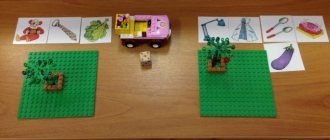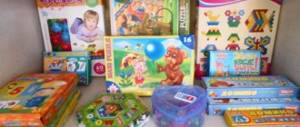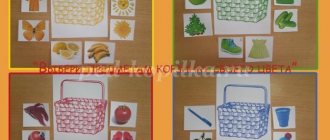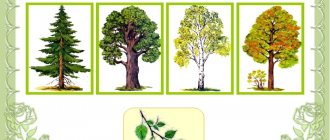Variations of entertainment or “I was born an artist”
You can diversify this fun so that children don’t get tired of repeating the same names. You can modify the counting rhyme and say:
“I was born an artist,
Seriously angry
I'm tired of all the colors,
Everything except yellow!
The guys choose the names of their colors in advance. The flow of dialogue is the same as in the case of “The Gardener”
A very interesting version of the game mentioning the profession of a pastry chef. Each child can choose the name of a confectionery product. For example, cake, candy, cake, cookies, caramel, marshmallows, pastille, waffle, straw, etc.
The following professions are also suitable:
- gardener - you can call vegetables;
- carpenter - pieces of furniture;
- toy store seller - names of toys are selected;
- ornithologist - called birds;
- seamstress - children choose the names of sewing products, for example, shirt, dress, trousers, blouse, etc.
In this game you can show your imagination and come up with something new every time.
Watch the video in which the guys themselves will explain how to conduct this fun event:
Didactic games “Plants” to familiarize yourself with the world around you
Tatyana Chikhlyaeva
Didactic games “Plants” to familiarize yourself with the world around you
Round dance game “Name the flower, (tree, bush)
»
Goal: to generalize knowledge and broaden children’s horizons about different types of plants
Materials and equipment: ball
Game rule: The players stand in a circle and pass the ball to each other, naming the type of plant , depending on the purpose of the game . The one who cannot name leaves the game . last one to name the plant wins .
Game “The Fourth Wheel” (work in small groups)
Goal: to generalize knowledge and broaden children’s horizons about different types of plants
Game rule: Children have four pictures depicting different types of plants : they need to choose the odd one out among the plants , and say why and justify their choice. (on the children’s tables there are pictures mixed with plants , among them you need to choose light-loving plants ; Pictures with indoor plants mixed with wild plants , you need to choose wild plants ; Flowering plants mixed with non-flowering plants plants among them ; Medicinal plants mixed with ordinary plants plants among them .)
Game "Magic bag"
Goal: to strengthen children’s ability to recognize plant by their characteristic features.
Materials and equipment: bag, mushrooms, fruits, vegetables
Game rule: The host offers to guess by touch what is in the bag. In order to complicate the game, another rule is proposed: several objects are placed in the bag. None of the children know about them. The called child, putting his hand into the bag and groping for one of the items, talks about it. The bag will open if the children recognize the vegetable from the description. Fruit or mushroom.
Game “Which tree is the fruit from?”
Goal: to consolidate children's knowledge about the variety of fruit trees. Activate the dictionary. Develop memory, observation, attention. Cultivate cognitive interest . Practice counting.
Materials and equipment: cards depicting various fruit trees and the fruits corresponding to these trees.
Game rule: Players are dealt cards (one or more, depending on the players)
.
The presenter takes out a fruit from a fruit tree. Whichever child finds the corresponding tree on his card, names the fruit and gives its description. The winner is the one who is the first to close the contours of the fruits on his tree.
Complication: count how many fruits are on the tree.
-name what kind of juice, jam, fruit drink, etc. can be prepared from the fruits shown in the picture.
The game "What's missing?" (play in pairs or small groups)
Goal: to promote the development of memory, attention, observation, to exercise the ability to apply existing knowledge in new conditions, to exercise in the formation of the genitive singular form. Fix the names of mushrooms and plants .
Material: bag, scarf or tablecloth; pictures, dummies: vegetables, fruits, flowers, mushrooms.
Game rule: In front of the child there are plot pictures or objects. The child lists them and examines them. Then the child is given time to memorize. After this, it is suggested that the child close his eyes. At this time, the second child removes one picture or turns it upside down. Asks the child the question: “What’s missing?”
.
The child opens his eyes, looks at it and answers, for example: “There are no currants,”
and so on.
Game "Collect the picture"
Goals: to strengthen children’s ability to identify the shape of an object, color, to teach how to correctly assemble an image of an object from individual parts; correlate the image of a representation with a holistic image of a real object, act by application.
Materials and equipment: Cards with images of various plants , parts of objects corresponding to the image on the cards.
Game rule: The children have cut-out pictures in front of them. The teacher invites the children to carefully examine and assemble the picture from individual parts. At the initial stage, children superimpose parts of a drawing onto a picture that matches this pattern. Children, in a group or individually, assemble a whole image on a carpet or table based on a pattern from cut-out pictures.
Lotto game “Bushes and trees”
Goal: To consolidate children’s knowledge about the variety of trees and shrubs, the ability to distinguish between them and find the right plant .
Materials and equipment: Playing field (4 pieces, divided into 6 squares with images of various trees and shrubs, corresponding to the images on small cards (24 pieces)
.
Game rule: Game for children from 4 years old. The game can be played by 3-5 people. Players are given game cards. The presenter pulls out a small card from a special opaque bag, the player or presenter names the tree or shrub shown on the card. Whoever finds the corresponding image on his field takes the picture for himself. This continues until one of the participants covers the entire playing field with pictures. For children over 5 years old, the game can be complicated. Name in one word the trees or shrubs depicted on the same playing field.
1. Oak, birch, willow, linden, chestnut, maple are deciduous trees.
2. Bird cherry, lilac, mimosa, magnolia, rose hips, jasmine are shrubs.
Game “What grows ?”
Goal: to consolidate children's knowledge about plants ; develop the ability to establish spatial connections between objects; group plants according to their place of growth , develop activity and independent thinking
Materials and equipment: old plates with pictures of trees, flowers, shrubs or mushrooms pasted in the middle (any group of flora )
and small pictures depicting representatives of a particular group.
Game rule: Players receive a plate with different pictures; small cards are in a box. At the driver’s signal, the children select small cards in accordance with the pictures on the plate. The winner is the one who quickly covers all the pictures on his plate and names the plants .
Game “Which tree is the leaf from?”
Goal: to reinforce with children the names of trees, the appearance of leaves and fruits;
develop attention, observation, memory;
cultivate cognitive interest .
Materials and equipment: Cards depicting trees and shrubs and their leaves.
Game rule: game for children from 4 years old.
You can play it alone or in a small group.
Invite the children to place leaves on trees of the appropriate appearance.
Game " Plant "
Goal: consolidate knowledge about parts of plants , instill a love of nature, interest, and develop the cognitive activity of children .
Materials and equipment: cut-out pictures depicting parts of the plant (inflorescence, petals, root, stem)
.
Game rule: Players are invited to assemble a whole plant from parts . Plants can be different : trees, shrubs, flowering plants , indoors. The manual can be used directly in educational activities, as well as in organizational activities and individually.
Game "Flower"
Goal: consolidate knowledge about parts of plants , make a whole from parts,
instill a love of nature, develop children’s cognitive activity , develop children’s speech.
Materials and equipment: crocheted thread flower; plant parts (with button)
- stem, flower, root, leaves, bud, seed with lightning.
Game rule: Using a button, attach the parts sequentially: from the root to the inflorescence.
Game "Make a bouquet"
Goal: to reinforce with children the names of colors and appearance;
develop attention, observation, memory;
cultivate cognitive interest .
Materials and equipment: subject pictures depicting flowers.
Game rule: The players look at the pictures and clarify the names of the colors depicted on them. Then, at the request of the presenter, bouquets of garden, forest or wildflowers are “made up”.
Game "Find a Pair"
Goal: to reinforce with children the names of trees, the appearance of foxes and fruits;
develop attention, observation, memory;
cultivate cognitive interest .
Materials and equipment: leaves and fruits of different trees or their images.
Game rule: The players are divided into two teams: one is given leaves, the other is given fruits. At the leader’s signal, the children become pairs so that the leaves match the fruits.
A correctly composed couple passes through the “magic gate”
(two children with their hands raised up)
.
If the task is completed incorrectly, the gate is closed (raised hands are lowered)
.
Game “What did people grow ?”
Goal: Goal: to reinforce with children the names of vegetables and fruits, appearance;
develop attention, observation, memory;
cultivate cognitive interest .
Materials and equipment: real fruits and vegetables or their images, 2 boxes or 2 baskets.
Game rule: Children are divided into teams. One of them "collects"
vegetables, the other - fruits. You can collect real objects or pictures with their images.
The team that completes the task faster wins.
Game “Where is the nesting doll hiding?”
Goal: to consolidate with children the names of plants in the group area , appearance;
develop attention, observation, memory;
cultivate cognitive interest .
Materials and equipment: matryoshka.
Game rule: The presenter shows the players a small nesting doll, then invites them to close their eyes and hides the toy behind one of the plants in the game sector . The players open their eyes and the presenter describes to them the plant (stem, leaves, flowers, behind which the nesting doll is hidden. The first one to correctly name the plant and find the matryoshka .
Game "Tops and Roots"
Goal: to reinforce with children the names of plants , the appearance of the above-ground and underground parts;
develop attention, observation, memory;
cultivate cognitive interest .
Materials and equipment: real tops
and
“roots”
of vegetables or pictures with their image.
Game rule: 1st option. The teacher divides the children into two groups. “roots” to one of them
(onions, turnips, carrots, potatoes, etc., the other is
the “tops”
of these
plants . All the “tops”
and
“roots”
are mixed. At the teacher’s signal:
“One, two, three - find your pair!”
all the children pick up a couple for yourself.
2nd option. "Roots"
stand still.
"Tops"
are running around the site .
At the teacher’s command, they must stand so that the tops and roots form one whole. The correctness of the task can be checked by the “magic gate” (two children)
or by the teacher himself.
Game “What vegetables are needed for borscht?”
Goal: to reinforce with children the names of vegetables and their appearance;
develop attention, observation, memory;
cultivate cognitive interest .
Materials and equipment: real vegetables or object pictures depicting them.
Game rule: The teacher invites the children to “cook”
borscht for lunch
Children choose the vegetables needed for borscht (cabbage, beets, beans, carrots, onions, etc.)
.
Among the vegetables there should also be those that are not needed for borscht (for example, cucumber, zucchini, etc.)
.
Game "Harvest"
Goal: to reinforce with children the names of vegetables and fruits, appearance;
develop attention, observation, memory;
cultivate cognitive interest .
Materials and equipment: subject pictures depicting vegetables, fruits and insects.
Game rule: Object pictures are placed face down on the table. The players take turns taking pictures. The one who took the picture with the image of an insect loses his turn, that is, he does not put the picture on the table, but puts it back, and all the pictures are mixed again.
with the biggest “harvest” wins
vegetables and fruits.
Game “What first, what then?”
Goal: to reinforce with children the names of vegetables and fruits, appearance, stages of their maturation;
develop attention, observation, memory;
cultivate cognitive interest
Materials and equipment: subject pictures.
Game rule: The presenter distributes vegetables and fruits to the children. At the signal: “Find your vegetable!”
Children holding vegetables and fruits of the same name are united into groups.
In each group they are placed, observing the sequence of ripening - from unripe to ripe. The team that lines up quickly and in the correct sequence wins.
Game “Let's collect the harvest in the field, in the garden, in the vegetable garden”
Goal: to reinforce with children the names of vegetables and fruits, grains, their appearance and their place of growth ;
develop attention, observation, memory;
cultivate cognitive interest
Materials and equipment: subject pictures depicting plants in the field , garden and vegetable garden.
Game rule: Three teams collect crops: the first - in the field, the second - in the garden, the third - in the vegetable garden. The team that is the first to correctly complete the game task wins.
Riddle game "Forest"
Goal: to reinforce with children the names of forest plants , appearance;
develop attention, observation, memory;
cultivate cognitive interest
Materials and equipment: pictures of forest plants .
Game rule: The teacher asks riddles, the children guess them. If the answer is correct, the presenter shows a picture of the answer.
At the end of the game, the result is summed up different plants grow in the forest , shrubs, berries, flowers, mushrooms, etc.
Game "Necessary - not necessary"
Goal: to reinforce with children the names of vegetables and fruits, appearance;
develop attention, observation, memory;
cultivate cognitive interest .
Materials and equipment: Pictures of plants .
Game rule: The presenter says: “I want to plant a vegetable garden. Do you need cabbage?
The children answer:
“Needed
.
When listing vegetable plants , the presenter also names fruit plants and flowers. Which of the children made a mistake leaves the game .
"Ambushed"
vegetable garden, the children continue the game - they begin to
“plant”
the garden. The presenter, when listing fruits, uses the names of vegetables and flowers.
who never makes a mistake wins
Game "Where does it grow ?"
Goal: to generalize knowledge and broaden children’s horizons about different types of plants and where they grow .
Materials and equipment: ball
Game rule: The teacher throws the ball to the children in turn and names the plant . Having caught the ball, the child must quickly answer where it grows - in the garden , in the forest, in the field, in the meadow.
Game "Plant a tree"
Goal: Development of visual attention, ability to navigate in space. Activation of the dictionary on the topic. Development of fine motor skills of the fingers.
Materials and equipment: geometric figures made of cardboard, various colors, counting sticks, cones, etc.
Game rule: Children made of parts (triangles, counting sticks)
They assemble a tree on a piece of paper on which
a line is marked - earth .
Didactic game "Gardener"
Expected result: children should know the names and appearance features of flowers growing in the kindergarten area; be able to describe their appearance and features; talk about flower care and the shape of a flower bed.
Goals: to develop the perception of color and its shades, monologue speech; develop an active interest in living nature.
* * *
The teacher travels with the children around the territory of the kindergarten and stops near the flower beds. A gardener is selected who must talk about the flowers growing in the flowerbed and how to care for them. The gardener's assistants complete the story. The use of poetry is encouraged. The teacher draws attention to the fact that children note the shades, the variety of flowers of the same type, the unique development of flowers in the shade, partial shade and in the sun.
Ball game "I know five colors"
Expected result: children should
know the names of meadow and garden flowers; be able to hit and catch the ball, rhythmically pronouncing the names of colors, without losing the tempo to combine a noun with a numeral.
Goals: to break down dexterity, speed of reaction, speed of thinking; to develop interest in using knowledge about colors in games with peers.
* * *
The child hits the ball on the ground and says: “I know five names of meadow flowers: chamomile - one, bell - two, carnation - three,” etc. If a child gets confused or takes a long pause, he loses and the ball is passed to another.
Afternoon
Didactic games
Call to the flower shop
Source:
[5].
Expected Result:
children should have an idea about the flower shop and its services; build dialogue; develop the plot, come up with new speech patterns, questions on the topic; use polite manners typical for telephone conversations.
Goals:
develop dialogical speech and imagination; create a culture of telephone communication.
For the full text of this game and other games with the phone, see the book: [5}.
Flower shop
Expected Result:
children should be able to play the roles of sales consultant and buyer, and conduct dialogue on their behalf; use polite figures of speech, clearly explain what product they need, how to package it, for what purpose it was purchased; connect purchases with the plots of role-playing games organized in parallel. '
Goals: to develop dialogical speech, aesthetic taste; create a culture of communication.
Materials: bouquets of artificial flowers, sets of postcards, books about flowers, vases, fabrics with floral patterns, perfumes, dried flowers, fragrant bags with dry petals, flower jam, flower soap, boxes of medicinal flower infusions, flower oil, etc. .
* * *
Before buying a product, a child must select it, consult with a sales consultant, describe it in detail, and explain the purpose of the purchase.
Labor in the flower garden
Expected Result:
children should have an idea of how different flowers are grown depending on the timing of flowering and whether they are annual or perennial;
be able to arrange cards with a schematic representation of the planting sequence in order, explain the order and significance of each stage; use the names of planting material (seeds, bulbs, tubers),
actions
(sow, plant, dig, loosen, soften, fill, water, fertilize, break a flowerbed, weed, replant, plant, divide a bush, trim, cut, insulate for the winter) .
Goals: to develop memory, verbal vocabulary, the ability to build a chain of events in a logical sequence; to develop an interest in knowledge that helps to increase natural resources.
* * *
Children-gardeners choose pictures with planting material and images of flowers (each in their own flower garden lays out the sequence of planting and caring for the selected flowers), talk about what flower beds they will create, how to place the plants, how to care for them throughout their growth and flowering. For the most detailed and correct stories, gardeners are awarded the “Flower Experts” medal.
Solving and composing simple crossword puzzles
Source:
[39] .
Expected Result:
children should be able to remember the names of colors and choose those that end with the letter “a”; count the number of letters in each name, write them according to the number of cells in a horizontal stripe or from the center of the crossword puzzle (children who do not write insert ready-made letters or call them to the teacher).
Goals: to develop the ability to think logically when composing a crossword puzzle; cultivate perseverance.
For children 6-7 years old, you can use a large set of postcards from which they will choose the ones they need.
Day Content Options
Didactic, games
Tell about yourself -
Expected result: children should be able to write a detailed descriptive story about the selected flower (structure, color, shape, size, flowering time, life expectancy, place of growth); guess the flower from the description; if necessary, supplement your story based on visual evidence.
Goals: to develop imagination, memory, monologue speech; cultivate an attentive attitude to the speech activity of a comrade.
* * *
The teacher invites the children to choose a flower about which they will write a riddle-description. Children must remember all the details of the appearance, place of growth, use gestures and pantomime when describing. The winner is the one who described it vividly, in detail, and the children were able to guess the flower. For the description, you need to take the flowers most known to children.
Gardener
Expected result: children should be able to remember the name of the selected flower; quickly respond to the driver’s words and conduct a dialogue.
Goals: develop memory, reaction speed, attention; foster honesty while following the rules of the game.
* * *
A gardener is chosen, the rest of the children are flowers.
Gardener. I was born a gardener, and I was seriously angry. I'm tired of all the flowers except the rose. (Names a specific flower.)
Child (playing the role of a rose).
I.
Gardener. What's happened?
Rose. In love.
Gardener. In whom?
Rose. To the chamomile.
The dialogue in a circle continues until one of the children has time to quickly answer “I”. Then the driver runs after the child and salts him. The one who was insulted becomes the leader.
»
Forest flowers
Expected result: children should know the distinctive appearance and blooming time of forest flowers in their native land; be able to guess a flower by description, find a picture with its image and place it next to the picture with the image, the season or its period; actively use a dictionary on the topic.
Goals:
develop memory, imagination, thinking; develop self-control, the ability to listen to a friend to the end, and not interrupt.
* * *
The teacher reads short excerpts from stories or poems with which the children were previously familiar, and then asks them to name a forest flower, find its image in the proposed pictures and place it with primroses (snowdrops), spring and summer flowers. Children play the role of young defenders of nature, grow forest flowers, which people often tear in whole bouquets and thereby harm nature. At the end of the game, each child chooses a flower that they would like to be in an imaginary wreath. The wreath is woven from hands in a circle. Children and their teacher dance in a circle. The number of texts is determined differentially.
Didactic exercises
Previous8Next
Didn't find what you were looking for? Use Google search on the site:







